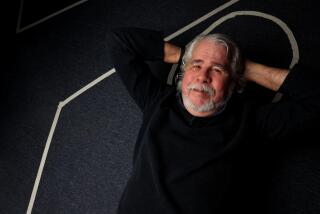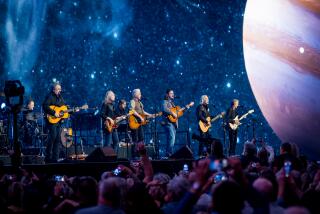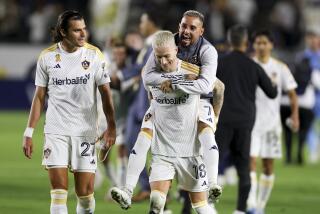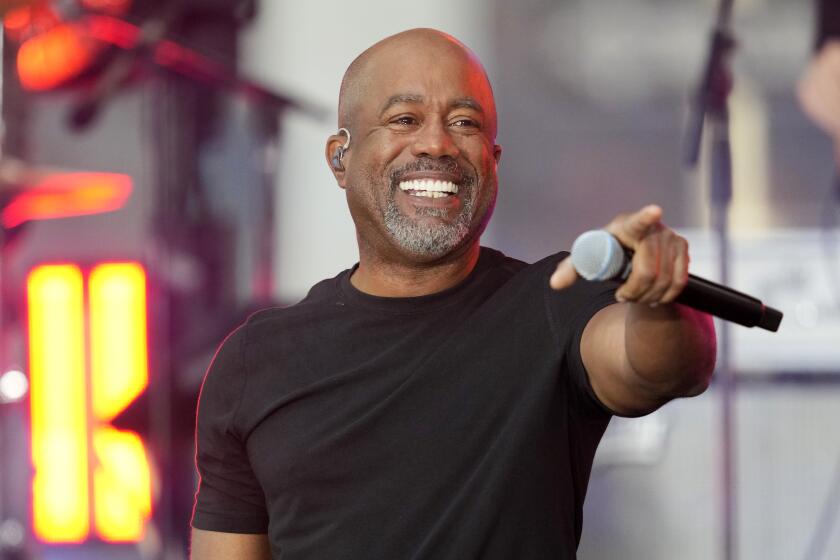A Dream of Very Little Substance : Pop music review: At the opening of Galaxy in Santa Ana, the band devotes its technical ability to material that’s flashy--and mostly meaningless.
SANTA ANA — Dream Theater was the serendipitous name of the opening-night headliner for the Galaxy Concert Theatre.
You could hardly dream up a better venue than the spacious, comfortable club, which proved itself artistically and logistically but flopped financially during a brief incarnation two years ago as the Rhythm Cafe.
The Rhythm Cafe’s demise was due partly to an addiction to off-putting swanky touches such as valet parking and a ritzy, high-priced dinner menu, but primarily to withering competition from the better-established Coach House in San Juan Capistrano.
Those obstacles are gone. The Galaxy’s proprietor is Gary Folgner, the Coach House owner who will run the two venues in symbiotic monopoly, virtually cementing his position as the only promoter in Orange County for major touring rock and pop attractions on the club level.
And Folgner, doubtless one of the most unassuming and least egotistical people in the entertainment business, doesn’t figure to make the Galaxy a palace of swank, although the atmosphere remains luxurious. The valets are not coming back.
As for the headlining band, there wasn’t much besides the name to make it a fitting opening-night attraction. Dream Theater, originally formed by classmates at Boston’s Berklee College of Music, combined bombastic progressive rock influenced by Yes and Emerson, Lake & Palmer with Gargantuan heavy metal a la Queensryche. That’s a fairly dubious premise to start with, and Dream Theater proceeded to accentuate the worst excesses of both styles.
Yes and ELP may have had their foolish and pretentious moments (well, a lot of them, actually). But before they lost their inspiration following early-’70s peaks, both bands wrote extremely seductive music that was not merely a springboard for Titanic displays of instrumental prowess. They were pop-rock bands as well as prog bands, and they could perform with delightful panache and a showmanly flair.
Dream Theater’s four instrumentalists--guitarist John Petrucci, bassist John Myung, drummer Mike Portnoy and keyboards player Derek Sherinian--devoted their considerable technical ability to music that had little purpose except to show off.
It was all sensation, built on swelling dynamics and thundering beats (the head-bangers in the house had no complaint about Portnoy’s brain-rattling dual bass drums). Most songs favored a choppy, jigsaw style of composition that allowed the players to show how shifty they could be but made for a diffuse listening experience.
*
Memorable melodies were few; emotional content was thin. The opening song, “Pull Me Under,” and the closing (before encore) acoustic ballad, “The Silent Man,” were among the few numbers in a nearly two-hour concert that proved Dream Theater can write a coherent, melodic song when it has a mind to.
Singer James LaBrie inflicted the worst sort of operatic heavy-metal vocal excess. Obviously there are people--as the full-house of 550 fans attested--who love this approach, in which Titanic grandeur and sheer lung power count for everything and the earthy, almost conversational flow of traditional rock singing is cast aside.
But if I were king, I would issue an edict that singers like LaBrie, Queensryche’s Geoff Tate and Ray Alder of Thursday night’s opening band, Fates Warning, be forced to wear choke collars designed for dogs that are nuisance-barkers. As soon as their throats swelled with one of those sustained high-note cries that LaBrie loves to inflict, complete with quaking vibrato, the choke collar would tighten, giving the singer a stark choice: perform on a human scale, or asphyxiate yourself.
Alas, the unrestricted LaBrie was free to make like Prometheus unbound or (as my ears hear it) a billy goat on steroids.
The progressive-rock tradition was built around bands that delighted in putting on a vivid show with a flashy look, emphasizing playfulness along with grandeur. Dream Theater was a drab lot whose members wore a standard-issue, all-black uniform of jeans and T-shirts.
They provided little action (the exception was drummer Portnoy, who kept twirling his sticks and waving his arms in grand flourishes as he held forth behind a kit as big as a Sherman tank).
LaBrie was a stiff front man with an impassive face and an immobile stage style; between songs, his main purpose was not to highlight themes and stories or to engage the crowd in a friendly way, but to communicate the fact that, although the current Dream Theater tour is ending, the band will most certainly be back next year. In that case, thank goodness for choice.
*
Fates Warning was closer to straightforward heavy metal, with two guitars and booming drums--and no keyboards. Singer Alder was somewhat less extreme with the operatics than LaBrie but didn’t have that much more of a stage presence, even though his round face and long black hair gave him a passing resemblance to Brad Pitt’s Louis the vampire.
It was hard for Alder to give a convincing rendition of his band’s dark and stormy repertoire, seeing as he had all he could do to keep from giggling while members of Dream Theater spent the set pelting Fates Warning with edible debris from their dressing room high above the stage. (The ammo appeared to consist mainly of popcorn, potato chips, crackers and assorted fresh vegetable slices.) The two bands are old buddies, so Fates Warning didn’t get mad about this end-of-tour hazing, although Alder returned fire from time to time.
Revenge came when a couple of the Fates brought out a miniature, pi-shaped model of a Stonehenge ruin while Dream Theater played one of its extended epics. They proceeded to dance a jig around it, in mimicry of a scene from “This Is Spinal Tap.”
Both bands expressed annoyance with the Galaxy’s table-seating layout, saying they preferred to play to standing admirers. Folgner said in an interview that he plans eventually to use the club’s stage-side pit as standing room during some rock shows. With a new security crew still being broken in, he said he wanted his staff to get more experience before handing it the challenge of a standing crowd where slam dancing might break out. There won’t be any moshing allowed in this Galaxy, Folgner said.
The club marked its opening night without hoopla; outside, the Galaxy’s sign hadn’t even been set up yet, and inside there were no announcements or ceremonies trumpeting the occasion.
In fact, Folgner said, as late as four hours before show time, it was in doubt whether the Galaxy would even open. He said that a paperwork problem in Sacramento had left the club without final approval of its liquor permit from state Alcoholic Beverage Control authorities.
It also lacked a certificate of occupancy from the city of Santa Ana. But the liquor license came through after feverish phone calls, and Folgner praised city inspectors for granting him a temporary, 30-day occupancy permit before the show, even though some work remains to be done.
Folgner said he will shortly fulfill the remaining requirements, including putting additional lighting in the parking lot, installing a hand-activated fire alarm system and doing some “minor” electrical work.
*
Four years ago, Folgner was in a similar situation on the opening night of his ill-fated Raymond Theatre venture in Pasadena. City officials found fault with the fireproofing in the theater’s seat cushions, and Folgner was forced to cancel its debut and refund 1,800 tickets. The theater subsequently opened but folded after a short run. In Folgner’s view, it never recovered from that opening-night debacle.
“In Pasadena, the city came out and shut me down for a few minor things,” he said. “Santa Ana said, ‘Hey, (take) two weeks and get it fixed.’ They want business in this town, and they do everything they can to help you.”
As a venue, the Galaxy is virtually unchanged from the Rhythm Cafe. Set up in five ascending tiers laid out in a semicircle around the stage, it is more like a theater than a nightclub. The capacity is 550, but with its high ceilings and expansive, carpeted interior, the room has the feel of a small concert hall that would seat more than 1,000 if it were laid out in rows of theater seats.
The Coach House, which seats 480, is by far the more intimate venue; it’s the more appropriate hall for acoustic singer-songwriters (although under the Rhythm Cafe regime, there were some good shows of that type).
The average seat at the Galaxy is farther from the stage, but the person sitting in it will have more room and comfort than at the Coach House. The new club’s big, padded chairs are positively luxurious contrasted with the hard, Spartan seats at the Coach House.
The Galaxy’s sight lines are almost perfect, save for a couple of support beams at the back in an area set aside for standing room. The acoustics are good, and the elaborate stage lighting is worthy of a concert hall.
Dream Theater trucked in its own mammoth sound system; Folgner said the Galaxy will have a house system installed in time for tonight’s concert by the acoustic guitar duo Strunz & Farah.
What’s best about the Galaxy is the choice it affords for a county that traditionally has been able to support just one club with a wide range of touring pop attractions.
Those not enamored of Dream Theater’s prog-metal approach could have gone to the Coach House and caught the Dave Matthews Band, an adventurous, jam-oriented acoustic ensemble. Tonight, music fans not taken with the refined, flamenco-style work of Strunz & Farah can try a shot of Dick Dale’s raw, surf-rock thunder at the Coach House. At last, monopoly may be working in the consumer’s favor.
More to Read
The biggest entertainment stories
Get our big stories about Hollywood, film, television, music, arts, culture and more right in your inbox as soon as they publish.
You may occasionally receive promotional content from the Los Angeles Times.











